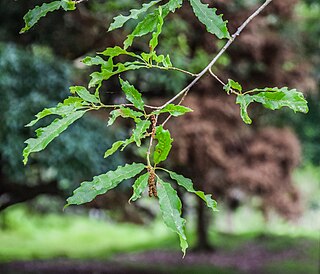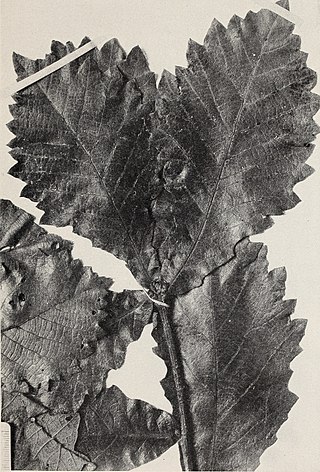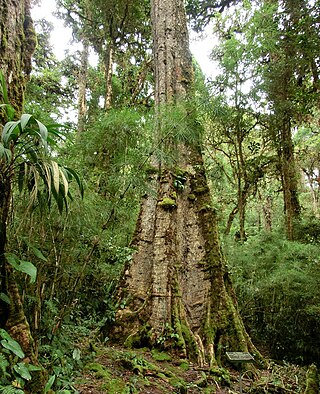
Quercus lancifolia is a species of oak found in Central America and Mexico.

Quercus benthamii is a species of oak in the family Fagaceae. It is native to the cloud forests of Central America and southern Mexico. It is threatened by habitat loss.
Quercus martinezii is a species of oak found in southwestern and central Mexico. It has been found in Nayarit, Jalisco, Michoacán, Guerrero, and Oaxaca states. It is placed in Quercus section Quercus.

Quercus uxoris is an uncommon species of oak.

Quercus xalapensis, or xalapa oak, is a species of oak in the red oak group. It is native to the mountains of eastern and southern Mexico, as well as Guatemala, Honduras, and Nicaragua in northern Central America.
The Central America bioregion is a biogeographic region comprising southern Mexico and Central America.

Quercus rugosa, commonly known as the netleaf oak, is a broad-leaved tree in the beech and oak family Fagaceae. It is native to southern North America.

Quercus glaucoides is an oak species in the white oak section, Quercus section Quercus, found in and endemic to eastern, central and southern Mexico.

Quercus polymorpha, the Mexican white oak, Monterrey oak or netleaf white oak, is a North American species of oak. It is widespread in Mexico, Guatemala, and Honduras, and known from a single population in the United States but widely planted as an ornamental.

Quercus laurina is a species of oak. It is native primarily to Mexico and has also been found in Guatemala and El Salvador.

Quercus magnoliifolia, also known as encino amarillo, encino avellano, encino bermejo, encino blanco, encino napis, encino prieto, and roble, is a Mexican species of oak. It is widespread along the Pacific Coast of Mexico from Sinaloa to Chiapas, and also found inland as far as Zacatecas and Puebla.

Quercus crassifolia is a species of oak. It is widespread in Mexico from Sonora and Chihuahua to Veracruz and Chiapas. It has also been found in Guatemala.

Quercus peduncularis is an oak in the white oak group native to Mexico and Central America, ranging from Jalisco to Honduras.

Quercus castanea is a species of oak tree. It is widespread across much of Mexico, from Sonora to Chiapas, and in Guatemala, El Salvador, and Honduras.

Quercus elliptica is a Mesoamerican species of oak tree. It is widespread across central and southern Mexico and Central America from Sinaloa and Hidalgo south as far as Nicaragua.
Quercus urbani, also known as Quercus urbanii, is a species of oak. It is native to western and central Mexico from Sinaloa, Durango, and Zacatecas to Oaxaca.

Quercus insignis is a Mesoamerican species of oak in the white oak section, within the beech family. It is native to southern Mexico and Central America, from Veracruz to Panamá.

Quercus sapotifolia is a species of oak. It is native to southern and western Mexico as well as Central America. It is threatened by habitat loss.
Carpinus tropicalis is a species of tree native to central and southern Mexico, Guatemala, El Salvador, Honduras, and Nicaragua.
Quercus segoviensis is a species of oak native to southern Mexico and northern Central America. It is commonly known as k’antulán.
















